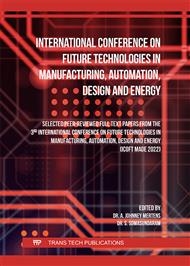[1]
N. D. Ghate, A. Sood, A. Srivastava & A. Shrivastava, "Ductile fracture based joint formation mechanism during friction stir welding," International Journal of Mechanical Sciences, 168, Nov. 2019.
DOI: 10.1016/j.ijmecsci.2019.105293
Google Scholar
[2]
S. Jana, R. S. Mishra, & G. J. Grant, "Chapter 2 – Friction Stir Processing: An Introduction," Friction Stir Casting Modification for Enhanced Structural Efficiency, 5-27, Nov. 2015.
DOI: 10.1016/b978-0-12-803359-3.00002-9
Google Scholar
[3]
R. V. Marode, S. R. Pedapati, T. A. Lemma & V. S. R. Janga, "Thermo-Mechanical Modelling of Friction Stir Processing of AZ91 Alloy: Using Smoothed-Particle Hydrodynamics," Lubricants, 10, 355.
DOI: 10.3390/lubricants10120355
Google Scholar
[4]
S. W. Kallee, J. Davenport & E. D. Nicholas, "Railway manufacturers implement friction stir welding," Welding Journal, 81, 47-50.
Google Scholar
[5]
C. Cavallo. "All About 7075 Aluminum (Properties, Strength and Uses)." Thomas Publishing Company. https://www.thomasnet.com/articles/metals-metal-products/all-about-7075-aluminum-properties-strength-and-uses/
Google Scholar
[6]
Patil, N.A.; Pedapati, S.R.; Marode, R.V. Wear Analysis of Friction Stir Processed AA7075-SiC-Graphite Hybrid Surface Composites. Lubricants, 10, 1–24, 2022.
DOI: 10.3390/lubricants10100267
Google Scholar
[7]
H. S. Arora, H. Singh, & B. K. Dhindaw, "Numerical simulation of temperature distribution using finite difference equations and estimation of the grain size during friction stir processing," Materials Science and Engineering A, 543, 231-242, Mar. 2012.
DOI: 10.1016/j.msea.2012.02.081
Google Scholar
[8]
R.V. Marode, S.R. Pedapati & T.A. Lemma, "Effect of Process Parameters on AZ91/SiC Surface Composites for Lightweight E-vehicles," 2022 7th International Conference on Electric Vehicular Technology, 109-115, (2002)
DOI: 10.1109/icevt55516.2022.9924699
Google Scholar
[9]
M. Grązka & J. Janiszewski, "Identification of Johnson-Cook Equation Constants using Finite Element Method," Engineering Transactions, 60(3), 215-223, Jan. 2012.
Google Scholar
[10]
B. Meyghani, M. B. Awang, M. Momeni & M. Rynkovskaya, "Development of a Finite Element Model for Thermal Analysis of Friction Stir Welding (FSW)," IOP Conference Series: Materials Science and Engineering, 495, 2019.
DOI: 10.1088/1757-899x/495/1/012101
Google Scholar
[11]
D. Yadav & R. Bauri, "Effect of friction stir processing on microstructure and mechanical properties of aluminium," Materials Science and Engineering: A, 539, 85-92, Jan. 2012.
DOI: 10.1016/j.msea.2012.01.055
Google Scholar
[12]
U. Acharya, B. S. Roy & S. C. Saha, "Effect of tool rotational speed on the particle distribution in friction stir welding of AA6092/17.5 SiCp-T6 composite plates and its consequences on the mechanical property of the joint," Defence Technology, 16(2), 381-391, Aug. 2019.
DOI: 10.1016/j.dt.2019.08.017
Google Scholar
[13]
L. Zhou, H. J. Liu & Q. W. Liu, "Effect of rotation speed on microstructure and mechanical properties of Ti-6Al-4V friction stir welded joints," Materials & Design (1980 – 2015), 31(5), 2631-2636, Dec. 2009.
DOI: 10.1016/j.matdes.2009.12.014
Google Scholar
[14]
O.P. Abolusoro, E. T. Akinlabi & S. V. Kailas, "Tool rotational speed impact on temperature variations, mechanical properties and microstructure of friction stir welding of dissimilar high-strength aluminium alloys," Journal of the Brazilian Society of Mechanical Sciences and Engineering, 42(176), Mar. 2020.
DOI: 10.1007/s40430-020-2259-9
Google Scholar
[15]
S. Bhojwani, "Smoothed Particle Hydrodynamics Modelling of the Friction Stir Welding Process," ETD Collection for University of Texas, Dec. 2007.
Google Scholar
[16]
O.P. Abolusoro, E. T. Akinlabi & S. V. Kailas, "Tool rotational speed impact on temperature variations, mechanical properties and microstructure of friction stir welding of dissimilar high-strength aluminium alloys," Journal of the Brazilian Society of Mechanical Sciences and Engineering, 42(176), Mar. 2020.
DOI: 10.1007/s40430-020-2259-9
Google Scholar


